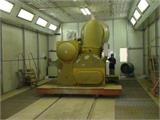Baidu Encyclopedia: Paint Mist Purification
Overview: Currently, the coatings used in spray painting are still solvent-based. The organic solvents—benzene, toluene, and xylene (commonly referred to as "the three benzenes")—in the paint film surface and paint mist directly volatilize into the workshop air. Simultaneously, tiny paint mist droplets form dust after the solvent evaporates, dispersing in the workshop air. The three benzenes belong to highly toxic solvents. During operations, they disperse into the workshop air, where workers inhale them through their respiratory system, which can cause both acute and chronic poisoning. This primarily leads to damage of the central nervous system and hematopoietic system. Short-term inhalation of high concentrations (1500mg/m³) of benzene vapor can cause aplastic anemia; frequent inhalation of low concentrations of benzene vapor can also lead to nausea, vomiting, confusion, and other neurological symptoms, with a few cases even leading to neurasthenia syndrome. Toluene is more toxic to the central nervous system than benzene but has less effect on the hematopoietic system. According to reports, long-term exposure to a benzene concentration of 188-375ug/m³ can result in noticeable subjective symptoms. The chronic harm of toluene is less than that of benzene, and symptoms can appear at concentrations between 43-1300mg/m³. When the three benzenes are mixed, they can irritate the eyes and nasal mucosa, and neurological symptoms become more severe. In summary, the hazards of paint mist to workers cannot be overlooked. Under high pressure, paint is atomized into fine particles, but during spraying with a spray gun, not all the paint reaches the spray-painted surface. These paint particles form paint mist with the airflow. To improve the working environment for workers within the workshop and meet environmental protection requirements, it is necessary to treat the paint mist for standard-compliant emissions. The SCGF type oil mist purifier produced by Sci-tech Environmental Protection Company integrates the most practical paint mist purification technologies from domestic and international sources, making it the ideal equipment for paint mist purification.
Scope of application: This equipment can be widely used for the purification treatment of low-concentration organic exhaust gas generated in industries such as petroleum, chemical, rubber, paints, coating, furniture, home appliances, and printing. It can handle various types of organic substances, including benzene, ketone, ester, alcohol, ether, and alkanes.
Working principle: This device consists of an oil mist absorption section, gas-liquid separation section, centrifugal separation section, high-efficiency filtration section, low-temperature plasma purification section, and activated carbon adsorption deodorization section. When the oil mist purification unit is operational, the paint mist first enters the atomization absorption section. This section uses waste engine oil atomization to absorb paint mist molecules, reducing the concentration of benzene-containing exhaust gases. After absorption, the paint mist then enters the gas-liquid separation section, where oil molecules and paint mist molecules are separated through inertial collisions and turbulent collisions in the gas-liquid separator. Subsequently, under the high-speed rotation and centrifugal force of the fan impeller, the flow rate and direction of the paint mist continuously change, causing the moving paint mist to collide, compress, and coalesce on the impeller. The coagulated paint mist forms micro-particles and is thrown into the inner wall of the box by centrifugal force before being drained via a leaky pipe. After centrifugal separation, the vast majority of paint mist molecules are removed, while the escaped molecules enter the ultra-fine sponge filtration section, where the large specific surface area of the ultra-fine sponge strongly intercepts oil and paint mist molecules. After the first four stages of purification, the paint mist molecules and oil mist molecules have mostly been removed. Then, the remaining molecules enter the plasma purification zone and odor removal zone, where micron and submicron-level molecules are degraded, sterilized, disinfected, and deodorized, releasing completely clean air.
Performance features:
1. No water required, environmentally friendly and energy-saving.
2. High efficiency in paint mist purification, with a purification efficiency reaching 90-99%.
3. Low operating resistance and energy consumption.
4. Simple device structure, convenient maintenance and repair.
5. Paint mist filtration materials have high purification efficiency, large dust capacity, flame retardancy, low resistance, and a long service life.
The paint mist purifier, commonly known as a spray booth, aims to maximize the purification of overspray paint mist during the workpiece painting process. The significance of the paint mist purifier is to achieve internal and external environmental protection objectives. It protects the physical and mental health of operators and reduces public nuisances. The paint mist purifier is one of the essential devices in the spray painting production line process. It uses paint mist filtration materials as the core component. Spray painting exhaust passes through multiple layers of gradually denser flame-retardant glass fiber materials. Through interception, collision, and absorption, the paint mist particles are accommodated in the material and gradually weathered into powder form, thus achieving the purpose of purifying the paint mist.




